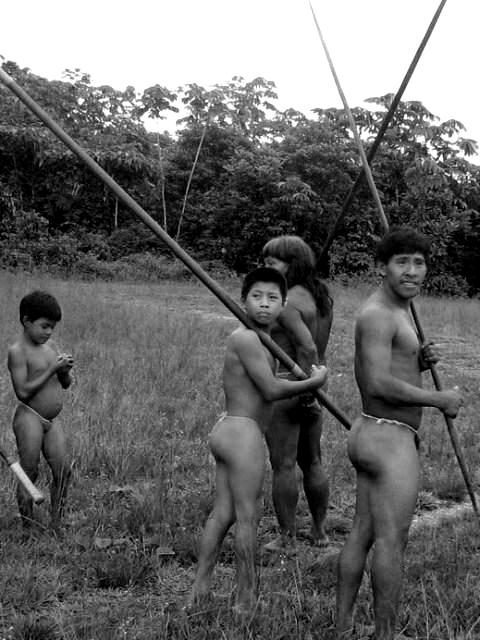
Native American Civilizations: Amazonian Tribes--The Huaorani (Ecuador)

Figure 1.--The Huaorani inhabit an area between the Curaray and Napo rivers in the Ecuadorian oriente. The Huaorani pursued a primitive hunter-gathering life style and in the past aggressively protected both their culture and lands from outsiders, especially settlers. Here we see Huaorani preparing for a hunt.
Since the 1970s, some Huaorani have begun to adopt more settled life styles in forest communities, although some bands continuetheir traditional ways and avoid outside contact. We also notice children attending a missionary school. On the wall of the school is written ,"I am a Wao child; I love my culture." The school has a program to preserve the native culture, however the way of life of these children is quite different from that of other bands who continue their trditional life style.
|
|
The Huaorani are an Amazonian tribe which have several different English languge names, including Waorani, Waodani, and Waos. Huaorani seems the most common, but there is no definitive English term. Ecuadorians often call them the Aucas, but this is an Inca (Quechua term - awqa) meaning enemy which was adopted by the Spanish. Little is know about their history, including why the militaristic Inca did not expand into the Amazonian areas inhabited by the Huaorani and other tribes. The Huaorani live in the Ecuadorian oriente, the eastern Amazon basin area of the country. They inhabit areas of Napo, Orellana and Pastaza Provinces between the Curaray and Napo rivers, about 50 miles (80 km) south of El Coca. The Huaorani are ethnically and culturlly destinct. The Huaorani language is a linguistic isolate. No information is available as to their origins and why they are so distinct. The tribe now number only about 4,000 people, this is larger than msny known Amazonian tribes. Their homeland is an area where oil exploration and illegal logging takes place. The Huaorani pursued a primitive hunter-gathering life style and in the past aggressively protected both their culture and lands from outsiders, especially settlers. Since the 1970s, some Huaorani have begun to adopt more settled life styles in forest communities, although some bands continue their traditional ways and avoid outside contact. We notice Huaorani boys at a mission school.
.
HBC

Navigate the Historic Boys' Clothing Web Site:
[Return to the Main Amazonian tribe page]
[Return to the Main South American Amazonian Native American page]
[Return to the Main South American Native American page]
[Return to the Main Native American page]
[Return to the Main Ecuadorian page]
[Introduction]
[Activities]
[Biographies]
[Chronology]
[Clothing styles]
[Countries]
[Bibliographies]
[Contributions]
[Essays]
[FAQs]
[Glossaries]
[Images]
[Links]
[Registration]
[Tools]
[Boys' Clothing Home]
Created: 1:21 AM 4/1/2011
Last updated: 2:39 AM 4/1/2011



